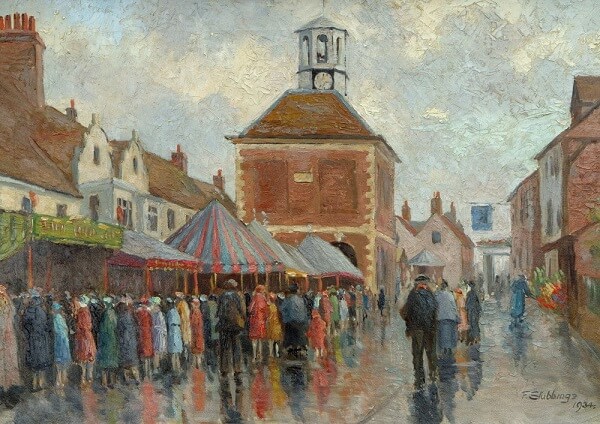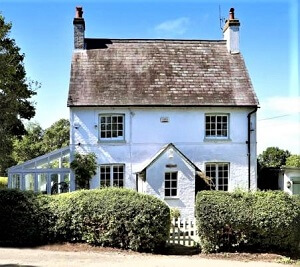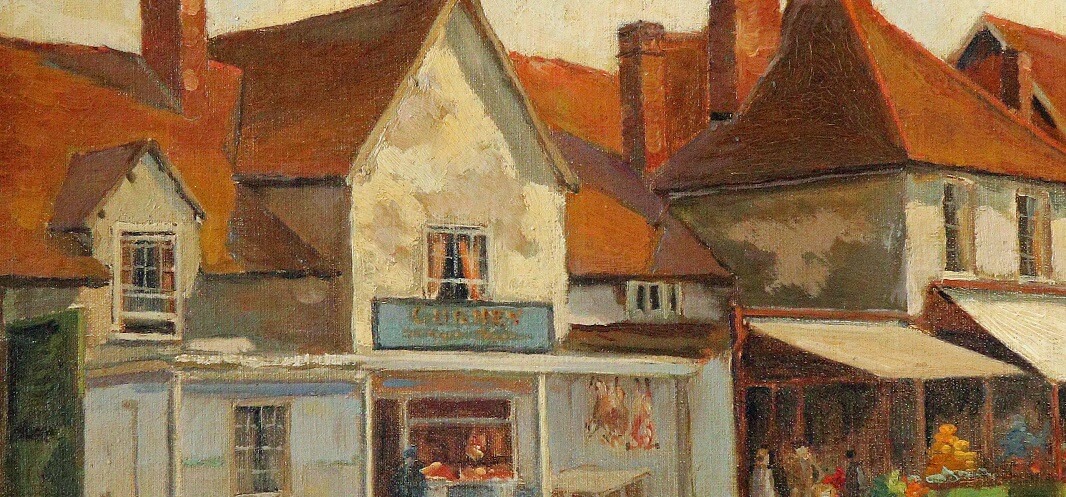Artist Fred Stubbings, “the grand old man of Coleshill”
by Alison Bailey

Fred Stubbings, who lived at Coleshill from 1900 until his death in 1956, was a well-known local artist, who loved to paint South Bucks landscapes and scenes from village life. Amersham Museum has recently added a fine Stubbings painting of an Old Amersham butcher’s shop to its collection, which already includes an atmospheric Stubbings’ painting of Amersham Fair in the rain. He enjoyed painting outside, whatever the weather, and often sketched scenes from the September Charter Fair. He recalled with delight the time a lady dropped twopence into his hat whilst he was painting there!
However, painting was only one of his talents. Fred Stubbing was headmaster of Coleshill Village School for 34 years, after moving to the village from a Metropolitan school, St Marys, in Willesden in 1900. Born in Cambridge in 1870, Stubbings was brought up in Sussex from young. His father, Stephen was a parchment maker. Fred trained as a teacher at Steyning Grammar school and became a schoolmaster in London. Here he met and married Edith Annie Smith, the daughter of a musician in 1893.
The family, which grew to include six children, lived first at Laburnum Villas and then Springfield, Tower Road. In the village he was remembered as a strict disciplinarian who presided over the school “with a rod of iron”. But he was also kind, always ready to help those in need, and quick to praise when it was deserved. A passionate naturalist, past pupils recalled walks where the children were encouraged to see how many wildflowers they could see and identify.

An accomplished musician, Fred Stubbings had a great tenor voice, and played the organ, piano, flute, and piccolo. He introduced the school children to classical music by playing to them on wet days. For 48 years he was the organist and choirmaster at All Saints Church, Coleshill and successfully entered both the church and school choirs for many competitions and festivals. The church choir certainly had enough practice. The choirboys were expected at rehearsal every Thursday and on a Sunday, at the 8am service, the 11am service, afternoon Sunday School and the 6pm service in the evening. If they were not in church on the Sunday, the pupils had to have a good excuse ready for Monday morning in school!
During the months of April and May nightingales, rare even then, could sometimes be heard at Coleshill during the evening. Stubbings said that he often played the church organ with the door open to encourage them to sing. He would play quietly as night was falling and listen to the hedgerow birds fall silent as the nightingales took up the song.
He must have had incredible energy and work ethic as he was also Superintendent of the Sunday School, secretary of the Church Council, chairman of Coleshill Parish Council, a special constable, founder of Coleshill Village Hall and a member of Amersham Rural District Council during WWII, when he organised the billeting of evacuees in the village. He also found time to be a prominent Freemason and a director of Amersham Building Society.
Stubbings was a keen, all-round sportsman and a crack shot. He played football for Amersham as well as hockey and cricket at Shardeloes. His son, Bob recalled how his father would run from Coleshill to Amersham to play football, and after the match run back up Gore Hill to the village again.

Coleshill Village School prospered under Stubbings’ care and greatly expanded despite the limited space. In his final years he led a fundraising drive to extend the facilities which, designed by the architects, Kemp and Howe, were completed by Amersham builder, Alfred Woodley in the 1930s. After his retirement he became the first teacher representative of Bucks County Education Committee. Retirement meant that he was also able to devote more time to his beloved art, which helped him cope with the death of his eldest son, Reginald in 1938 and his wife, Edith in 1939.
Initially self-taught, he studied Art at night school in High Wycombe soon after moving to Bucks and was proficient because he practised constantly. He painted 100s of local landscapes and was particularly fond of painting Coleshill Pond. According to the local press “his canvases in oils, pastels and watercolours have played a major part in putting the Chiltern landscape into people’s living rooms”.

Stubbings became friends with the celebrity artist, Louise Jopling, joining her Chiltern Club of Arts in 1919 and founding the Bucks Art Society with her in 1920. He was a later chairman of the society in 1948. He participated in many exhibitions, including the Royal Institute of Oil Paintings in 1927. In 1933 he held the first one man show at the Bucks Art Society to raise money for local charities. Just two weeks before his death, at the age of 85, he held his sixth one man show which raised £82 to repair the church organ he’d played for nearly 50 years. He said: “As I have probably helped wear it out more than anyone, I thought I would put on this exhibition.”
In 1996 the Penn Barn Gallery held a popular retrospective exhibition of Stubbings’ work and the Coleshill Historical Society is currently planning an exhibition of his paintings postponed due to covid. Please contact me at [email protected] if you have a Stubbings hanging on your wall or can add any further information.

